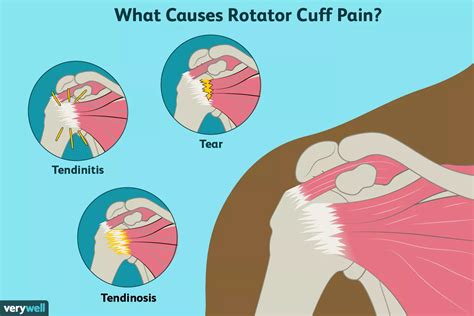Intro
Alleviate rotator cuff pain with 5 effective treatment methods, including physical therapy, exercises, and injections, to reduce inflammation and improve shoulder mobility and strength, relieving tendonitis and rotator cuff injuries.
Rotator cuff pain is a common issue that affects millions of people worldwide, causing discomfort, limited mobility, and reduced quality of life. The rotator cuff is a group of muscles and tendons that surround the shoulder joint, providing stability and facilitating movement. When the rotator cuff is injured or inflamed, it can lead to pain, weakness, and decreased range of motion. In this article, we will explore the importance of addressing rotator cuff pain, its causes, and most importantly, effective ways to treat it.
Rotator cuff pain can be acute or chronic, depending on the underlying cause. Acute rotator cuff pain is often the result of a sudden injury, such as a fall or a direct blow to the shoulder. Chronic rotator cuff pain, on the other hand, develops over time due to repetitive strain, poor posture, or age-related wear and tear. Regardless of the cause, it is essential to address rotator cuff pain promptly to prevent further complications, such as tendonitis, bursitis, or even rotator cuff tears.
The consequences of untreated rotator cuff pain can be severe, leading to prolonged periods of disability, reduced productivity, and increased healthcare costs. Furthermore, rotator cuff pain can also affect daily activities, sleep quality, and overall well-being. Therefore, it is crucial to seek medical attention if you experience persistent or severe rotator cuff pain. A healthcare professional can diagnose the underlying cause and recommend appropriate treatment options.
Understanding Rotator Cuff Pain

Causes of Rotator Cuff Pain
The causes of rotator cuff pain can be divided into two main categories: traumatic and non-traumatic. Traumatic causes include falls, direct blows, or sudden contractions, which can lead to acute rotator cuff pain. Non-traumatic causes, on the other hand, include repetitive strain, poor posture, and age-related wear and tear, which can lead to chronic rotator cuff pain. Other factors, such as muscle imbalances, scapular dyskinesis, and degenerative conditions, can also contribute to rotator cuff pain.Treatment Options for Rotator Cuff Pain

- Physical Therapy: Physical therapy is a crucial component of rotator cuff pain treatment. A physical therapist can help you develop a personalized exercise program to improve flexibility, strength, and range of motion. Techniques such as manual therapy, modalities, and functional training can also be used to reduce pain and inflammation.
- Pain Management: Pain management is essential for rotator cuff pain treatment. Over-the-counter pain medications, such as acetaminophen or ibuprofen, can be used to reduce pain and inflammation. In some cases, prescription medications, such as corticosteroids or muscle relaxants, may be necessary.
- Rest and Ice: Rest and ice are essential for acute rotator cuff pain treatment. Avoiding activities that aggravate the condition and applying ice to the affected area can help reduce pain and inflammation.
- Stretching and Strengthening Exercises: Stretching and strengthening exercises can help improve flexibility and strength, reducing the risk of further injury. Exercises such as shoulder rolls, arm circles, and shoulder blade squeezes can be performed to improve rotator cuff function.
- Surgery: In severe cases, surgery may be necessary to repair or replace the damaged rotator cuff tendon. Surgical options include arthroscopic repair, open repair, or reverse shoulder replacement.
Benefits of Treatment
The benefits of treating rotator cuff pain are numerous. Effective treatment can reduce pain, improve mobility, and restore function. Additionally, treatment can also prevent further complications, such as tendonitis, bursitis, or rotator cuff tears. By addressing rotator cuff pain promptly, individuals can return to their daily activities, improve their quality of life, and reduce healthcare costs.Prevention Strategies

- Maintain good posture: Good posture can help reduce the risk of rotator cuff pain by minimizing strain on the shoulder joint.
- Strengthen the shoulder muscles: Strengthening the shoulder muscles, particularly the rotator cuff, can help improve stability and reduce the risk of injury.
- Avoid repetitive strain: Avoiding repetitive strain, such as lifting heavy objects or performing repetitive movements, can help reduce the risk of rotator cuff pain.
- Take regular breaks: Taking regular breaks, especially during activities that involve repetitive movements, can help reduce the risk of rotator cuff pain.
Conclusion and Next Steps
In conclusion, rotator cuff pain is a common issue that requires prompt attention. By understanding the causes and mechanisms of rotator cuff pain, individuals can take steps to prevent and treat the condition. Effective treatment options, such as physical therapy, pain management, rest and ice, stretching and strengthening exercises, and surgery, can help reduce pain, improve mobility, and restore function. By taking a proactive approach to rotator cuff health, individuals can maintain optimal shoulder function, reduce the risk of further complications, and improve their overall quality of life.We encourage you to share your experiences with rotator cuff pain in the comments below. Have you tried any of the treatment options mentioned in this article? What strategies have you found most effective in managing rotator cuff pain? Share your thoughts and help others who may be struggling with this common condition.
What are the common causes of rotator cuff pain?
+The common causes of rotator cuff pain include traumatic injuries, repetitive strain, poor posture, and age-related wear and tear.
What are the symptoms of rotator cuff pain?
+The symptoms of rotator cuff pain include pain, weakness, and reduced mobility in the shoulder joint.
How can I prevent rotator cuff pain?
+You can prevent rotator cuff pain by maintaining good posture, strengthening the shoulder muscles, avoiding repetitive strain, and taking regular breaks.
What are the treatment options for rotator cuff pain?
+The treatment options for rotator cuff pain include physical therapy, pain management, rest and ice, stretching and strengthening exercises, and surgery.
How long does it take to recover from rotator cuff pain?
+The recovery time for rotator cuff pain varies depending on the severity of the condition and the effectiveness of treatment. In general, it can take several weeks to several months to recover from rotator cuff pain.
